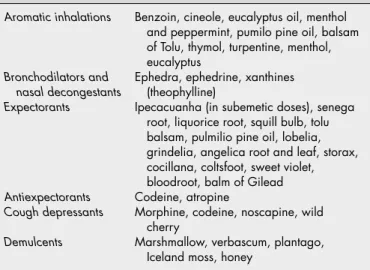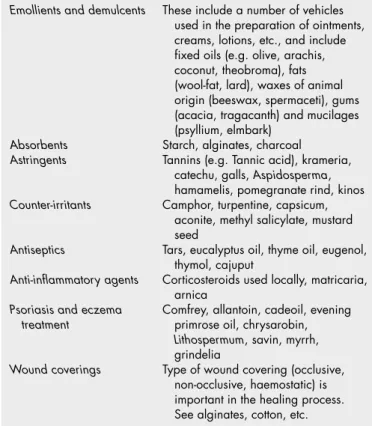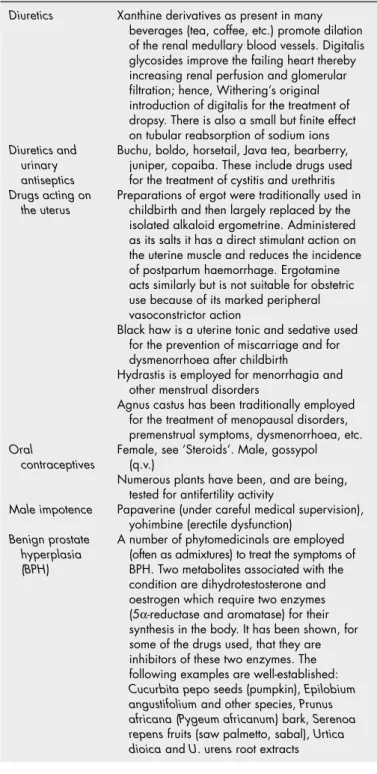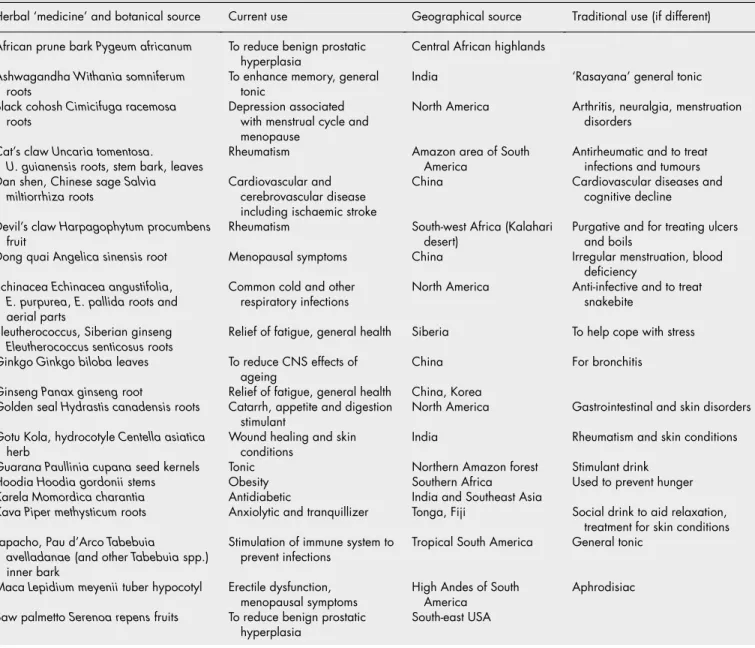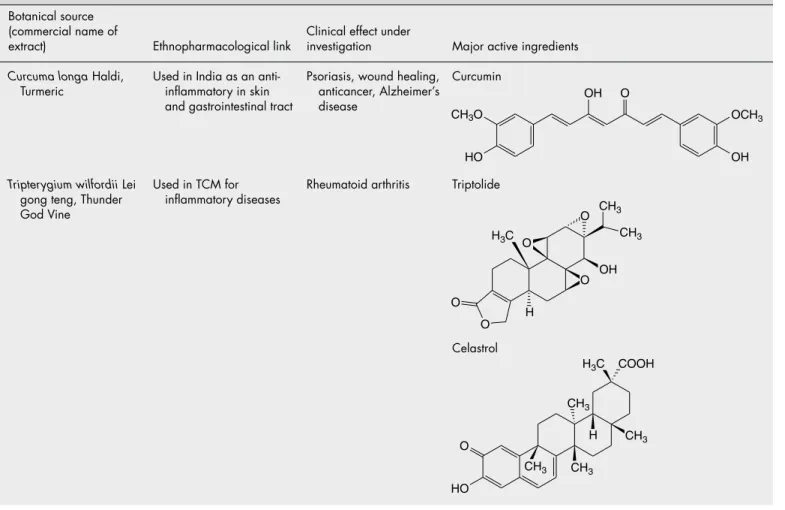The national pharmacopoeias of many countries and the European Pharmacopoeia; the latter's relevant crude drug monographs are included in the British Pharmacopoeia. The treatment of the plants in these works can be along any of the lines above.
CLASSIFICATION 9
BOTANICAL NOMENCLATURE
SUBDIVISIONS OF THE PHYLA
Students need not attempt to learn these names by heart, and in the following pages they are usually omitted, except in cases where different botanical names have been applied to the same plant at different times and there is a possibility of confusion.
BOTANICAL SYSTEMS OF CLASSIFICATION
TAXONOMIC CHARACTERS
The appearance of a particular character in certain plants does not necessarily imply a relationship between these plants, because at some time in the past, under favorable conditions, entire groups of unrelated plants could have undergone this change (eg of multiple petals; this is known as convergence). Computers play a clear role in dealing with large numbers of characters applied to thousands of plants, not only from the aspect of information storage and retrieval, but also for the science of numerical taxonomy, which is likely to play an increasing role in the development of systematics.
CHEMICAL PLANT TAXONOMY
Since some groups of plants are more primitive than others on the evolutionary scale, some characters will also be primitive while other characters will evolve from them. Parallelism refers to the similar development of characters in related plants or related groups of plants.
2 The plant and animal kingdoms as sources
- BIOLOGICAL AND GEOGRAPHICAL SOURCES OF DRUGS 15
- A TAXONOMIC APPROACH TO THE STUDY OF MEDICINAL PLANTS AND ANIMAL-
- PHARMACOLOGICAL ACTIVITIES OF NATURAL PRODUCTS 45
- SYNERGY AND OTHER INTERACTIONS IN PHYTOMEDICINES 53
- TRADITIONAL PLANT MEDICINES AS A SOURCE OF NEW DRUGS 62
- DISCOVERING NEW LEAD COMPOUNDS IN PHARMACEUTICAL RESEARCH AND
In the current search for new drugs that have, for example, antitumor or hypotensive activity, the plants involved, unlike many of the more traditional drugs, often show no direct evidence of pharmacological activity. Researchers in the US have genetically engineered microbes to produce a precursor to the antimalarial drug artemisinin, which is then chemically engineered to give the bioequivalent drug.
GEOGRAPHICAL SOURCES
THALLOPHYTES 18
LICHENS 21
PTERIDOPHYTA 21 GYMNOSPERMS 22
THALLOPHYTES
BACTERIA AND ALGAE
Bacterial action is used, for example, in the production of vinegar, acetone, butyl alcohol, lactic acid and L-sorbose. They are single-celled algae, have a siliceous skeleton, and show infinite variety in the shape and formation of the cell wall.
FUNGI
The fungi also produce spores without significance in the alternation of generations. In the Mucoraceae we have Mucor (40 spp.) and Rhizopus (8 spp.), which are among the molds associated with poorly stored foods.
LICHENS
BRYOPHYTES AND PTERIDOPHYTES
BRYOPHYTA
PTERIDOPHYTA
The dried sterile stems of horsetail, Equisetum arvense are used in herbal medicine and are listed in BHP (1996) and BP/EP. The use of young shoots for culinary purposes is discouraged, and avoidance of pungent spores in the atmosphere is suggested.
GYMNOSPERMS
Araucaria (18 spp.) provides useful timber; and Agathis (20 spp.), the resins known as copals or anime, which are used for varnish. Low yields from bark and a lack of raw material that led to damage to forests from over-harvesting, often illegal, hindered drug development.
ANGIOSPERMS: DICOTYLEDONS
The largest genus, Podocarpus (100 spp.), ranges from tropical to temperate zones and produces valuable timber. A family of one genus (Cephalotaxus) and seven species of trees and shrubs (plum yew) found from the eastern Himalayas to Japan.
SUBCLASS ARCHICHLAMYDEAE
Alkaloids are important constituents of the family and have been reviewed (J. M. Barbosa-Filho et al., The Alkaloids. The family contains coloring and tanning substances, and phenolic compounds some of which cause dermatitis (eg, the vesicant constituents of the poison ivy, Rhus toxicodendron ).
SUBCLASS SYMPETALAE
In addition to olive oil (q.v.), the family produces sugar alcohols (eg manna mannitol), saponins, tannins, coumarins and iridoid glycosides. The seeds of Nux vomica (q.v.), the seeds of Strychnos nux-vomica, are the principal source of strychnine and brucine; calabash-curare (see 'Curare') owes its activity mainly to Strychnos species.
ANGIOSPERMS: MONOCOTYLEDONS
Constituents of the family include starch and fructosans, phenolic acids, anthocyanins, terpenoids and sterols; only isolated examples of alkaloids (alkaloidal amine and an indole alkaloid) are reported. Volatile oils and pungent principles as found in ginger (q.v.) are a feature of the family.
ANIMAL PRODUCTS
TRACT 48
DRUGS 50
DRUGS ACTING ON THE NERVOUS SYSTEM
In general, increasing the activity of the sympathetic system prepares the body for immediate action (fight and flight), while stimulation of the parasympathetic or vagal system produces effects more related to those that occur during sleep and energy conservation. Two important neurotransmitter substances of the autonomic nervous system are acetylcholine and norepinephrine and their derivatives; therefore, other substances that mimic or antagonize the action of any of these will produce a marked physiological response.
THE HEART, CIRCULATION AND BLOOD
Among the hypotensive plant medicines, roodolfia and its main alkaloid reserpine along with Veratrum extracts were recognized in allopathic medicine in the early 1950s. In the circulatory system, thrombi can form on the arterial side due to the adhesion of platelets to each other and to the walls of the blood vessels.
ACTION ON THE GASTROINTESTINAL TRACT
One of the first natural products identified was the neolignan kadsurenone obtained from Piper futokadsura, a plant long used in traditional Chinese medicine to treat allergies. Extracts of the maidenhair tree, Ginkgo biloba, have proven particularly interesting and are commercially available in Europe for the treatment of various circulatory disorders.
THE NASAL AND RESPIRATORY SYSTEMS
THE LIVER
THE URINARY AND REPRODUCTIVE SYSTEMS
THE SKIN AND MUCOUS MEMBRANES
ACTION ON SUGAR METABOLISM
STEROIDS AND ANTI-INFLAMMATORY DRUGS
NON-STEROIDAL ANTI-INFLAMMATORY DRUGS
Colchicine, an alkaloid from Colchicum autumnale, is the classic drug for the treatment of an acute attack of gout. Guaiacum resin (q.v.) is cited for the treatment of chronic rheumatic diseases and gout; it contains a mixture of lignans.
TREATMENT OF INFECTIONS
Lipoxygenase inhibitors are present in Spilanthes oleracea (a S. American plant of the Compositae used for the treatment of rheumatic disorders) and also in Echinacea purpurea root, also Compositae, which contain a range of compounds including isobutylamides. The dried root of Harpagophytum procumbens (Devil's Claw) (Pedaliaceae), has recently received popular attention for the treatment of painful rheumatic conditions; iridoid glycosides, e.g.
TREATMENT OF MALIGNANT DISEASES
In addition to the wide variety of plants involved, there is a similar diversity in the chemical nature of the active ingredients. In the case of an extract of matricaria flowers (Chamomilla recutita, German chamomile), which is used for its anti-inflammatory action in the treatment of acute gastritis, it was shown by the mouse ear test that it is the flavonoids and not the volatile not. oils responsible for activity; however, for Calendula officinalis, the terpenoids were found to be active ingredients (see Anon., Pharm. J.
TREATMENT OF ALLERGIES
Enzymes have been used to detect the anti-inflammatory activity of plants - galangin, a flavonoid of Alpinia officinarum (Zingiberaceae; . galangal rhizome) was found to be an inhibitor of cyclo-oxygenase. With licorice root (Glycyrrhiza glabra) both the triterpenoid saponin glycyrrhizin and flavonoids have, among other pharmacological actions, anti-inflammatory activity.
THE IMMUNE SYSTEM
Flavonoids form one group widely associated with anti-inflammatory activity and are exemplified in the BHP (1996) by the monographs on Balm of Gilead, Cimicifuga Rhizome, Equisetum, Jamaica Dogwood, Marigold, Matricaria Flowers, Meadowsweet, Poke Root, Clover and Willow Bark. It may act by reducing the inflammatory response caused by deposits of urate crystals in the joint and by reducing phagocytosis of the crystals.
VITAMINS
The term 'synergy' (or synergy, from the Greek syn-ergo, meaning to work together) refers to the phenomenon where two or more agents act together to produce a greater effect than would be predicted by a consideration of individual contributions. It is generally assumed that synergy plays a role in the effects of phytomedicines, and the use of combinations of herbs is central to the philosophy of Western medical herbalism, Traditional Chinese Medicine (TCM) and Ayurveda.
WHAT IS SYNERGY?
M. Williamson
PHYTOMEDICINES 55
MEASURING SYNERGY
However, if synergy occurs, smaller amounts are required to produce the effect (ie the effect of the combination exceeds expectation) and the equation becomes dA/DA + dB/DB < 1, and the isobole is said to be 'concave' be. The isobole method can also be applied to mixtures in which only one of the two substances is active; in effect 'potentiation'.
DEMONSTRATING SYNERGY AND POLYVALENT ACTION IN
The axes on the graph (Fig. 7.1B) represent doses of the two compounds on a linear scale. In this case, the iso-effective dose of the agent lacking activity can be considered infinitely large, so that the additivity isobol runs parallel to the respective dose axis.
ENHANCEMENT OR REDUCTION OF ABSORPTION OR BIOAVAILABILITY
Potentiation of the effect of berberine by 5¢-methoxyhydnocarpine in Berberis extract in preventing bacterial resistance. Rodrigues et al 2008 Opposite effects of the flavonoids isoquercitrin and sissotrin, isolated from Pterospartum tridentatum, on oral glucose tolerance in rats.
NEW TECHNOLOGIES FOR LOOKING AT SYNERGY AND OTHER INTERACTIONS
This study is important because it supports the idea that the chemopreventive properties of the Asian diet may be due to interactions between different components. In Asia, where soy product intake and tea consumption are very high, aggressive prostate cancer is significantly less common than in other parts of the world.
CONCLUSION
DEFINITION 62
DEFINITION
HISTORICAL DIMENSION
J. Houghton
Scientific interest in ethnopharmacology has increased over the last few years and this is reflected in the establishment of the International Society for Ethnopharmacology in 1990 and the European Society for Ethnopharmacology at around the same time. Preoperative sedative and analgesic, hallucinogenic preparations in many parts of the world Table 8.1 Some common drugs derived from traditional medicinal plants.
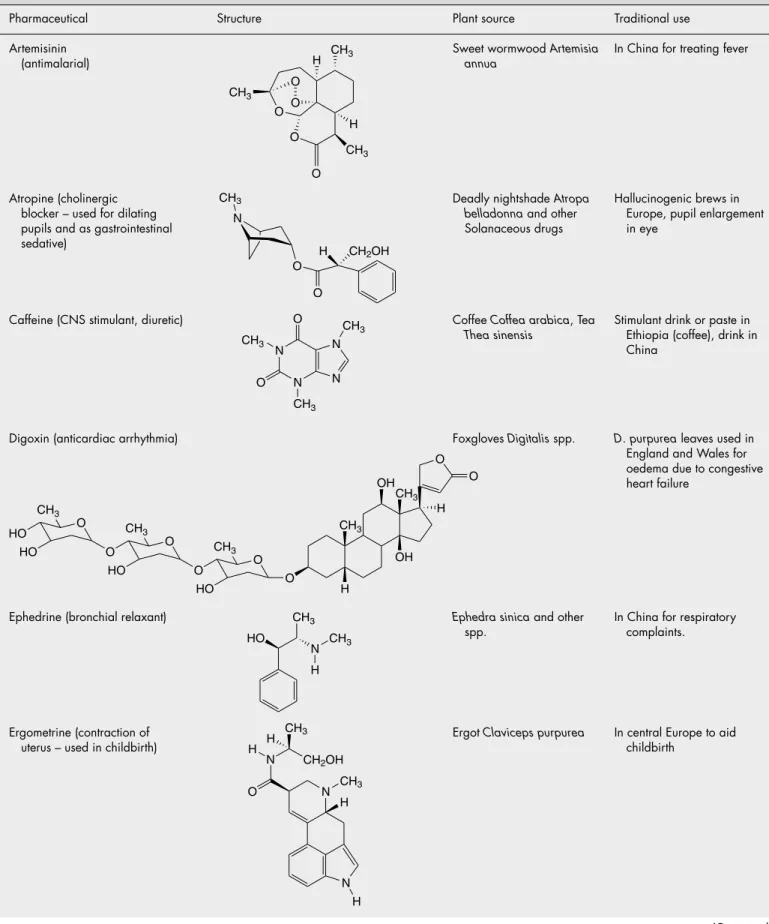
OHOH
It should be noted that such extracts, usually based on a known traditional practice somewhere in the world, have been introduced in the West and are increasingly being used as a complementary therapeutic approach. Treatment of Parkinson's disease Table 8.2 Some important drugs developed from molecules found in traditional medicinal plants.
OCH3
Herbal "Medicine" and Botanical Source Current Use Geographical Source Traditional Use (if different) African Prune Bark Pygeum africanum To reduce benign prostate. Fatigue relief, general health Siberia To help cope with stress Ginkgo Ginkgo biloba Leaves To reduce CNS effects of.
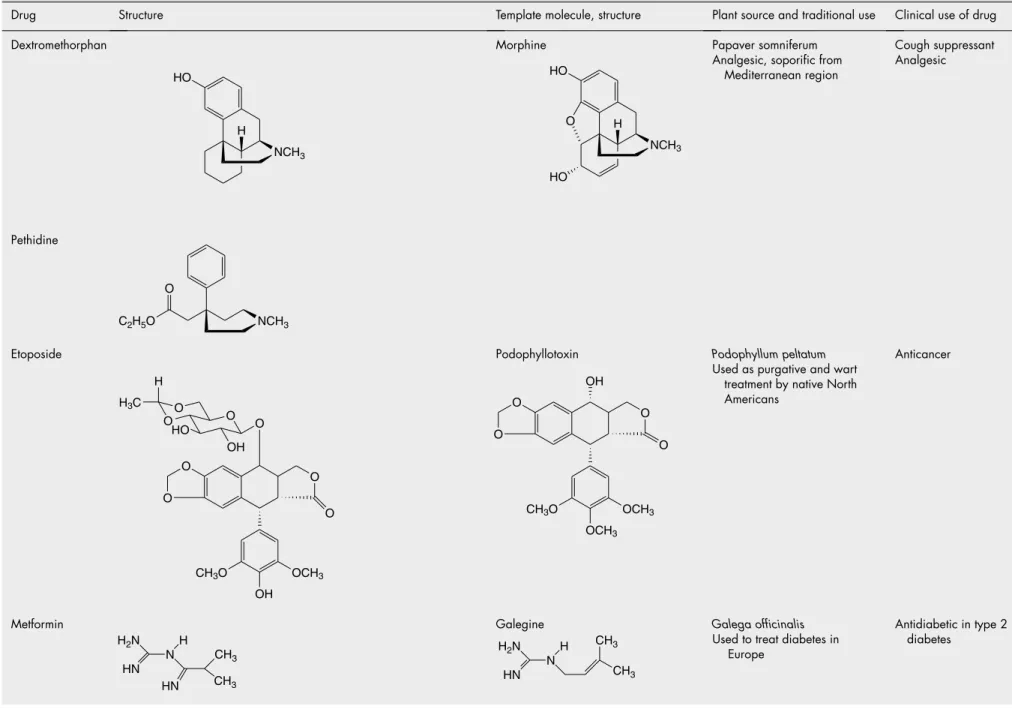
THE PROCESS OF MODERN DRUG
DISCOVERY USING ETHNOPHARMACOLOGY
Despite the common use of in vitro bioassays, ethnopharmacological research may take a different approach when a particular biological effect of a traditional medicine or poison has been observed but the causes are unknown. To be of maximum value, the range of tests chosen should be closely related to the possible underlying causes of the disease, e.g.
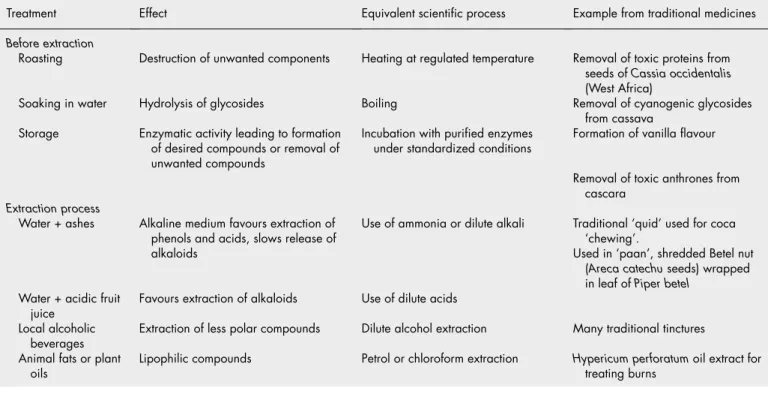
SOME MODERN EXAMPLES OF DRUG DISCOVERY BASED ON THE
These techniques are also valuable in dereplication, the process by which known active compounds present in the extract are detected, and thus time is not wasted in a lengthy bioassay-led process culminating in the 'discovery' of a known compound not.
THE VALUE OF THE
ETHNOPHARMACOLOGICAL APPROACH
Not specified, possibly fatty acid derivatives Ginkgo biloba Ginkgo Used in TCM for asthma.
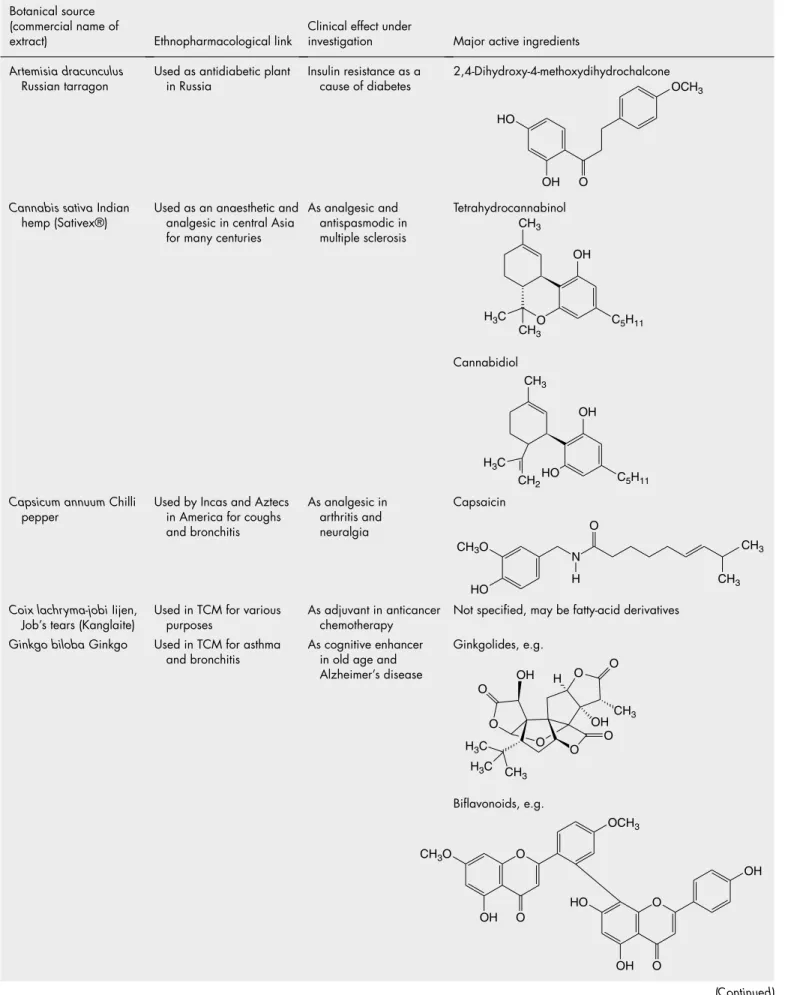
PROBLEMS WITH THE
INTELLECTUAL PROPERTY RIGHTS (IPR) ISSUES The commercial aspects of the ethnopharmacological approach have sparked much controversy in recent years regarding the intellectual property rights of groups with knowledge. In some cases, natural materials continue to be the only viable commercial source of the active compound.
BIOLOGICAL ASSAYS AND HIGH- THROUGHPUT SCREENING
The plates are then counted in a scintillation counter to determine the binding of labeled bradykinin to the receptors expressed on the surfaces of the cells. In the infectious disease arena, it is still common to perform high-throughput, whole-cell antifungal or antibacterial assays to detect samples that inhibit growth of the designated strain, e.g.
SAMPLE AVAILABILITY FOR HIGH- THROUGHPUT SCREENING
Screening of plant extracts for antitumor activity involves assays against a wide variety of cancer cell lines and mechanism-based in vitro targets, which have been extensively documented (Pezzuto, 1997). Mechanism-based assays often require sophisticated or expensive reagents: an assay for the activity of DNA ligase I involves incubating plant extracts with recombinant human DNA ligase I cDNA and its radiolabeled substrate and measuring the uptake of 5¢-32P labeled phosphomonoesters in alkaline-resistant phosphatases diesters (Tan et al., 1996).
SELECTING SAMPLES FOR SCREENING
The agreements will cover matters such as the permitted use of resources and the nature and timing of any benefits to be shared. Different strategies can be adopted depending on the extent of the natural material collections available and on the capacity and "robustness" of the target itself.
PROCESS FOR IDENTIFICATION OF PLANTS FOR TARGETED SETS
Perhaps the most striking observations available are ethnobotanical reports on traditional medicinal uses of plants.
SAMPLE PREPARATION
DE-REPLICATION AND ISOLATION OF ACTIVE COMPONENTS
AN EXAMPLE OF THE SUCCESS OF HIGH-THROUGHPUT SCREENING OF
- COMMERCE IN CRUDE DRUGS 83 11. PRODUCTION OF CRUDE DRUGS 87
- PHYTOCHEMICAL VARIATION WITHIN A SPECIES 106
- DETERIORATION OF STORED DRUGS 117
- QUALITY CONTROL 121
O'Neill MJ, Lewis JA, Noble HM et al 1998 Isolation of triterpene-containing translactone with thrombin inhibitory activity from Lantana camara leaves. Sampson JH, Phillipson JD, Bowery N et al 2000 Ethnomedicinally selected plants as sources of potential analgesic compounds: indications of in vitro biological activity in receptor binding assays.
Principles related to the commercial production,
HISTORICAL DEVELOPMENTS
Baker
The establishment of the East India Company in 1600 established a near-monopoly on the importation of. Merchants, brokers, and buyers met at the Corn Exchange, and deals were made by word of mouth (and sometimes in secret whispers) in the best traditions of commerce.
CURRENT ASPECTS
The Grocers' Company coat of arms, which depicts nine carnations (Flores Eugenia Caryophilia), testifies to the importance of the trade. Finally in 1985 the name was changed again, this time to the "International General Produce Association" to reflect the current true nature of the trade.
CHANGING DEMANDS
THE FUTURE
DRYING 91 STORAGE 92
SOURCE MATERIALS
ENVIRONMENTAL CONDITIONS
Annual temperature fluctuations are just as important as the temperature of the hottest month. Plants vary widely in the amount and intensity of light they require.
CULTIVATED AND WILD PLANTS
The depletion of the ozone layer and the consequent effect of increased radiation on the earth's surface has been a subject of much recent speculation. Nitrogen fertilization has been shown to increase the silymarin content of Silybum marianum fruits grown on reclaimed soil.
COLLECTION
In Guatemala, young Cinchona ledgeriana grafts are grafted onto Cinchona succirubra rootstocks, eventually producing a tree that produces bark rich in the alkaloid quinidine. Budding consists of inserting a piece of bud-bearing bark into a suitable cavity or T-shaped slot made in the bud-bark.
DRYING
When the length of drying was increased to 10 and 15 days, as in the shade house or in the laboratory, this had a negative effect on taxane recovery. In the case of digitalis stem and leaves, it should be noted that BPC and BP specify the temperatures at which drying should be carried out.
STORAGE
For drying in sheds, the drug may be suspended in bundles from the roof, threaded into strings, as in the case of Chinese rhubarb, or, more commonly, placed in trays made of bags or canned wire mesh. Alternatively, heat can be applied by means of open fires (eg nutmegs), stoves or hot water pipes.
EUROPEAN REGULATIONS
AUXINS 93 GIBBERELLINS 94
ETHYLENE 97
AUXINS
COOHO
There have been several reports on the effects of auxins on the formation of secondary metabolites on medicinal plants. The study of the effects of auxins on alkaloid formation has mainly concentrated on the tropane alkaloids of Datura species.
GIBBERELLINS
Much work has been published on the effects of the hormone on the morphology and alkaloid content of treated plants. In 1959, Sayed and Beal reported the effects of daily GA treatment of first-year rosette Digitalis purpurea plants.
CELL DIVISION HORMONES: CYTOKININS
Detailed results vary, but the general result is a reduction in oil content (possibly by reducing the number of glandular hairs) with little change in oil composition. Only a limited study has been done on the effects of cytokinins on secondary metabolism in intact plants.
GROWTH INHIBITORS
OHCH
In the latter there was an 18% increase in leaf yield and a 16% increase in hyosin content compared to the controls. In Cassia angustifolia plants, low concentrations of hormone were found to slightly increase the sennoside content and promote an increase in shoot dry weight.
ETHYLENE
Little or no work appears to have been done on the effects of abscisic acid on the production of substances of pharmacognostic interest. Several synthetic growth inhibitors have been investigated; the first to be described in 1949 was maleic hydrazide.
INDUSTRIAL SIGNIFICANCE
A large amount of work has been reported during the past decade and the majority of common medicinal plants, and many less common plants, have been subjected to cell culture investigation. Prod there are probably as many tombstones as milestones along the way in the development of plant tissue culture systems for the production of secondary metabolites.
CULTIVATION OF PLANT CELLS
To maximize the cell mass produced, the cell suspension culture eventually becomes very compact and this poses problems regarding even aeration. Most pilot studies have used fermenters of 5-15 liter capacity and the reported scale-up to 20,000 and more recently 75,000 liters in West Germany and Japan presents chemical engineering problems of considerable complexity.
PRODUCTION OF SECONDARY METABOLITES
In the case of Catharanthus roseus cultivars, for example, recent research has focused on the production of the dimeric alkaloids vinblastine and vincristine (q.v.), important anticancer drugs. Other plants yield cultures which produce a different spectrum of secondary metabolites than those found in the intact plant.
INDUCED SECONDARY METABOLISM IN CELL CULTURES
Daily doses of UV-B radiation (KJ m−2) caused an increase in the production of the flavonoids orientin, isoorientin, vitexin and isovitexin. After 7 days, isoorientin accumulation in callus reached levels comparable to those in fresh leaves of greenhouse-grown plants.
BIOCHEMICAL CONVERSIONS BY PLANT CELL CULTURES
Interesting and potentially useful hydroxylation and oxidation reactions have also been demonstrated for the biotransformation of podophyllum lignans in cell suspension cultures of Forsythia intermedia (A. J. Broomhead and P. M. Dewick, Phytochemistry. Many other biochemical transformations by cell cultures have been demonstrated and ester formation and saponification, glycosylation, hydroxylation, isomerization, methylation and demethylation and oxidation.
IMMOBILIZED PLANT CELLS
Some biotransformations are stereo-specific and have the potential to isolate optically active compounds from the racemate. For this technique to be commercially viable, the product must be substantial, the substrate must be available in reliable quantities, and the reaction must not be readily carried out by microorganisms or by chemical means.
ORGAN CULTURE
Increased production of alkaloids occurs when roots develop from the callus cultures of the tropane alkaloid-producing Solanaceae. Compared to the few examples given in the 13th edition of this book, there is now a substantial bibliography on transformed root cultures of medicinal plants.
CLONAL PROPAGATION
In addition to those mentioned above, which involve submicroscopic point mutations related to a change in the DNA chromosomal material, there are other genetic variations that can affect the chemical constituents of the species. Two consequences of the above are that, on the positive side, it provides the opportunity for the selection and establishment of superior strains with respect to the chemical constituents, as described in this chapter.
CHEMICAL RACES, CHEMOTYPES, CHEMODEMES
CH=OCH 3
In the same family, Ocotea pretissa provides sassafras-type oils that may or may not contain camphor. Further examples of chemical races among volatile oleaginous drugs of the Labiatae can be found in Chapter 22.
CHANGES IN CHROMOSOME NUMBER
OCH3 O
Blakeslee's radiation work on Datura stramonium resulted in the production of many types of single gene mutations (eg Zigzag, Quercina, Bunchy, Equisetum - names derived from several characteristic aspects of the plant). In many cases Blakeslee was able to map the position of the genes responsible for these effects.
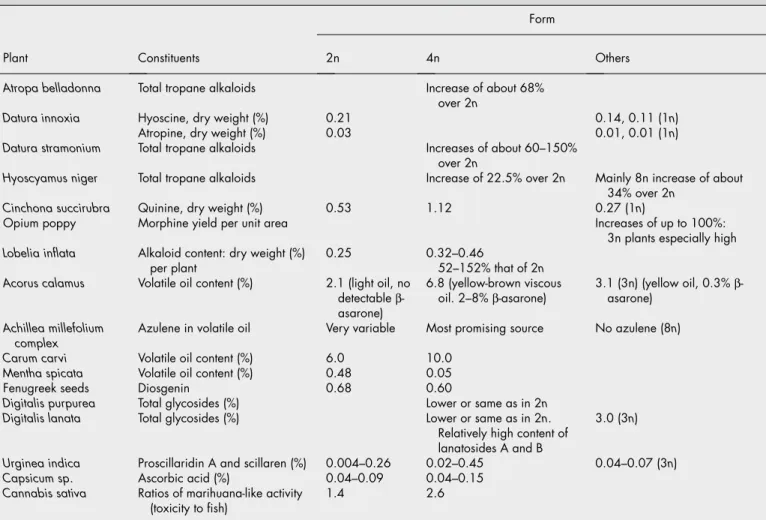
HYBRIDIZATION
This is important in commercial tobacco production, where both the amount and the nature of the alkaloid produced are important. The inheritance of opium alkaloids (morphine, codeine, thebaine, narcotine and papaverine) was studied in the cross Papaver somniferum × P.
TRANSGENIC MEDICINAL PLANTS
Fig. 14.3
An example of the possible potential for increasing the yield of alkaloids in Cinchona is shown by the successful integration of two genes from Catharanthus roseus into the hairy roots of Cinchona officinalis (A.-Geerlings et al., Plant Cell Reports. As a result of the transfer, quinine and quinidine levels rose above normal for C.
PRIMARY FACTORS
MOULD AND BACTERIAL ATTACK
COLEOPTERA OR BEETLES
LEPIDOPTERA
ARACHNIDA
Mites are commonly found in common household dust, such as those found under carpets, in mattresses, etc.; and these include Dermatophagoides pteronyssinus, D. This mite (Fig. 15.2C) does not show the clear division of the body into two parts exhibited by Tyroglyphus spp.
CONTROL OF INFESTATION
Pharmacol developed a method based on the acetolysis of the weighed sample for the quantitative isolation of the insect fragments present. The use of lycopodium spores (94,000 spores mg−1) eliminates the need to count all strial punctures present in a given volume (or weight) of suspension; the use of lycopodium powder in this regard is described below.
SPOILAGE BY RODENTS
The quantitative determination of insect infestation in powdered herbal medicines is of some importance. Pharmacol developed a method based on acetolysis of the weighed sample for the quantitative isolation of the insect fragments present. Using the fact that the number of strial punctures per elytron is characteristic of a particular beetle, by counting the strial punctures visible on the fragments of elytra present under the microscope, one can arrive at a figure for the number of beetles present.
STANDARDS APPLICABLE TO CRUDE DRUGS
These substances are used for their bitter effect and specific directions for determining the standard are given under each monograph. The problems and the nature of the toxic residues are essentially those in the food industry and in a number.
STANDARDS APPLICABLE TO VOLATILE AND FIXED OILS
For the pharmacopoeial test, the sample is shaken with 0.1 m sodium hydroxide for at least 2 hours and the filtered solution is purified with a solid phase extraction column. Chiral purity tests are specified for the volatile oils of caraway, neroli and lavender, and also for carvone.
ASSAYS
GENERAL METHODS ASSOCIATED WITH THE PHYTOCHEMICAL
BASIC METABOLIC PATHWAYS AND THE ORIGIN OF SECONDARY
Phytochemistry
Indeed, it was during this time that the attention of natural product chemists turned to the elucidation of the actual biosynthetic pathways found in the plant. Due to the recent interest in the plant kingdom as a potential source of new drugs, strategies have been developed for the fractionation of plant extracts based on biological activity rather than a specific class of compounds.
EXTRACTION OF PLANT MATERIAL
Parallel to this, the pharmacological evaluation of the separated components can be, which in some studies can precede the characterization. The method, combined with gas chromatography and mass spectrometry, has recently been applied to the analysis of flowers and essential oils of Lavandula angustifolia grown in N.E.
SEPARATION AND ISOLATION OF CONSTITUENTS
CICH
According to the nature of the charge on the ions of the solute mixture, the solutes will move towards either the anode or the cathode. If preferred, paper can be replaced by thin layers of the gels described below.
CHARACTERIZATION OF ISOLATED COMPOUNDS
This method was largely developed for the resolution of protein mixtures and depends on the specific, reversible binding of individual proteins with a particular ligand, such as an enzyme substrate or inhibitor. Affinity chromatography has been applied for the purification of enzymes for potential clinical application, for the isolation of certain antibodies and for the specific fractionation of different types of cells (e.g. erythrocytes and lymphocytes).
BIOGENETIC INVESTIGATIONS
For the use of competitive feeding in the elucidation of the biogenesis of tropane alkaloids, see Beresford and Woolley, Phytochemistry. Petal discs have been used in the study of rose oil biosynthesis.
ENZYMES
The activity of enzymes is clearly influenced by the reaction of the medium and the presence of substances such as salts. Riboflavin (Fig. 31.2) is a component of the two coenzymes flavin mononucleotide (FMN) and flavin adenine dinucleotide (FAD).
CARBOHYDRATE UTILIZATION
Photosystem I involves an electron acceptor and the subsequent reduction of ferredoxin in the production of NADPH. After the light reactions, a series of dark reactions then use NADPH in the reduction of carbon dioxide to carbohydrate.
GLYCOSIDES
OPO 3 H 2 Glyceraldehyde 3-
Many pathways of initial glucose metabolism are known for different living tissues. The overall reaction for the metabolism of one molecule of glucose in terms of ADP and ATP is.
OPO 3 H 2
It should be noted that one molecule of glucose can create two molecules of pyruvate, each of which is. The above schemes, given in the most detailed outline, are essential not only for the construction and breakdown of reserve food products, but also in that the intermediates are available for the biosynthesis of all other groups of compounds found in plants.
OH Dihydroxy-
- OH H O.X OX + H 2 O Sugar
The sugars found in glycosides can be monosaccharides such as glucose, rhamnose and fucose or, less commonly, deoxysugars such as cymarose found in cardiac glycosides. Virtually all natural glycosides, however, are of the β type, although the α linkage occurs naturally in some carbohydrates such as sucrose, glycogen, and starch.
FATS AND FATTY ACIDS
Thus, it appears that these ACP thioesters are obligatory intermediates in fatty acid synthesis, while it is the fatty acid thioesters of coenzyme A that work in the catabolic oxidation pathway. Eight enzymes have been identified as involved in the synthesis of palmitoyl-ACP and stearoyl-ACP from acetyl-CoA.
AROMATIC BIOSYNTHESIS
- Anthranilic acid
- OPO 3 H 2C
- COOH COOH COOH
- COOH
The system of fatty acid biosynthesis in plants appears to function in the same way as in animal tissues, but while in the latter the enzymes are located in the cytoplasm, in plants they are found in the mitochondria and chloroplasts. Isoflavones are formed in the same way, with a rearrangement of the aryl B ring relative to the three carbon atoms (Fig. 18.11).
AMINO ACIDS
Pyruvic acid
CH(NH 2 ) COOHHOOC
COOH
In animal tissues, tetrahydrofolic acid (THFA) has been shown to be responsible for the removal of the hydroxymethyl group from serine to form hydroxymethyltetrafolic acid. For an overview of the biosynthesis and metabolism of aspartate-derived amino acids (lysine, threonine, methionine, S-adenosylmethionine) see R.
PEPTIDES AND PROTEINS
COOH
There is evidence that α-ketoisovaleric acid is aminated to form valine and that it can also be condensed with acetate to form an intermediate which on decarboxylation and amination gives leucine (Fig. 18.16). These have already been mentioned in the discussion of the biosynthesis of aromatic compounds.
CO COOHCH3
CH COOHCH3
ISOPRENOID COMPOUNDS
COO− ATP
Rohmer et al. (Biochem. J showed that there is a non-mevalonate pathway for the formation of hopane-type triterpenoids in bacteria. Further steps, including a skeletal rearrangement, yield isopentenyl pyrophosphate—the same methyl-branched isoprenoid building block that is formed by the MVA pathway.
SECONDARY METABOLITES
OPPMe
It was soon demonstrated that this new route to IPP was also effective in the formation of monoterpenes (Mentha piperita, Thymus vulgaris), diterpenes (Ginkgo biloba, Taxus chinensis) and carotenoids (Daucus carota). Recent work on the biosynthesis of the isoprene units of chamomile sesquiterpenes (K.-P. Adam and J. Zapp, Phytochemistry has shown that for the three C5 units of both bisaboloxide A and chamazulene, two were mainly formed from non -mevalonate pathway and the third was of mixed origin.
OPPHa
This raised the question to what extent the two pathways coexisted in the plant and it was hypothesized that the classical acetate/mevalonate pathway was a feature of cytoplasmic reactions, while the triose/pyruvate sequence was a feature of the plastids. . This excluded neither the movement of plastid-synthesized IPP and DMAPP from the organelle to the cytoplasm nor the translocation of an appropriate C5 acceptor into the plastid.
OPPRC
Enzymology related to secondary metabolism is now receiving considerable attention, and many enzymes related to the biosynthesis of tropane, isoquinoline, and indole groups have been prepared in connection with alkaloid formation. Although many biogenetic groups are characterized by a specific skeletal structure, the actual chemical properties of certain compounds are determined by the acquisition of functional groups.
5 Pharmacopoeial and
- HYDROCARBONS AND DERIVATIVES 173 20. CARBOHYDRATES 194
- PHENOLS AND PHENOLIC GLYCOSIDES 219 22. VOLATILE OILS AND RESINS 263
- SAPONINS, CARDIOACTIVE DRUGS AND OTHER STEROIDS 304
- MISCELLANEOUS ISOPRENOIDS 333
- CYANOGENETIC GLYCOSIDES, GLUCOSINOLATE COMPOUNDS, CYSTEINE DERIVATIVES AND
- ALKALOIDS 353
- THE SEARCH FOR NATURALLY DERIVED ANTICANCER AGENTS 416
- ANTIPROTOZOAL NATURAL PRODUCTS 428
- AN OVERVIEW OF DRUGS WITH ANTIHEPATOTOXIC AND ORAL HYPOGLYCAEMIC ACTIVITIES 436
- ANTIBACTERIAL AND ANTIVIRAL DRUGS 445 31. VITAMINS AND HORMONES 451
- THE PLANT NUTRACEUTICALS 459
- COLOURING AND FLAVOURING AGENTS 471 34. MISCELLANEOUS PRODUCTS 477
IntroductionDrugs from the European and British Pharmacopoeias, together with some related plant materials, are discussed in some detail in Chapters 19-26. Overviews of some areas of this research, with their notable successes, are given in Chapters 26-29 and together with Chapters 8 and 9 illustrate the current approach to the search for 'new' drugs with potential value to the allopathic system of medicine.
HYDROCARBONS
MONOBASIC ACIDS
CHMe
The position of the double bonds is then indicated by the convention n-x, where n = the number of carbon atoms in the molecule and x is the number of carbon atoms inclusive from the methyl (ω) end to the first carbon of the first double bond, in this case 3, so the symbol for α -linolenic acid 18:3(n-3). Some natural acetylenes and acetylenic fatty acids have obvious structural similarities to more common fatty acids.
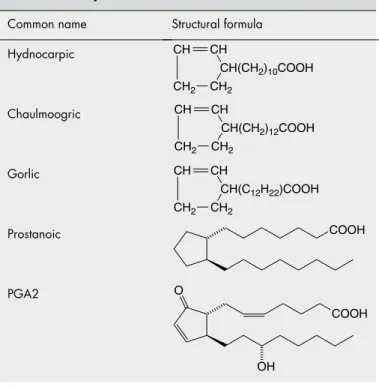
DIBASIC AND TRIBASIC ACIDS
COOH Citric acid
Similarly, p-coumaric acid (p-hydroxycinnamic acid), ferulic acid (hydroxymethoxycinnamic acid), caffeic acid (hydroxycinnamic acid) and 3,4,5-trimethoxycinnamic acid are derived from cinnamic acid. Other natural sources rich in this acid and potentially useful in the future are the needles of Pinaceae (S.
COOH cis-Aconitic acid
Its main source was star anise fruit (q.v.), which led to a supply shortage of the plant material. Tropic acid and phenyllactic acid are two aromatic hydroxy acids that occur as esters in tropane alkaloids (q.v.).
COOH Isocitric acid
Other related acids that are quite common are those with phenolic or other groups in addition to a carboxyl group; these are: salicylic acid (o-hydroxybenzoic acid), protocatechuic acid (3,4-dihydroxybenzoic acid), veratric acid (3,4-dimethoxybenzoic acid), gallic acid (3,4,5-trihydroxybenzoic acid) and 3,4,5-trihydroxybenzoic acid. 4,5-trimethoxybenzoic acid. Acids with an alcohol group are quinic acid (tetrahydroxyhexa-hydrobenzoic acid), which occurs in cinchona bark and in some gymnosperms; mandelic acid, C6H5CHOHCOOH, which occurs in combination in cyanogenetic glycosides such as those of bitter almonds and other species of Prunus; and shikimic acid, an important intermediate metabolite (see Figure 18.8).
ALCOHOLS
Of interest are opins, a group of substances produced by the host plant after infection with Agrobacterium spp.; many of these compounds are di- and tri-carboxylic acids. Sorbitol is abundant in many pink fruits, mannitol in manna and dulcitol in Euonymus species.
ESTERS
- OCOR 1
- OPO N(CH 3 ) 3
- OH Glycerol
- OCOC 15 H 31
- OCOC 15 H 31H31C15OCOCH
- OCOR 3
The acetyl value is the number of milligrams of potassium hydroxide required to neutralize the acetic acid released by the hydrolysis of an acetylated fat or other substance. It is expressed as the number of milligrams of potassium hydroxide required to neutralize the acid combined with acylating the sample.

DRUGS CONTAINING ACIDS, ALCOHOLS AND ESTERS
Ash Leaf BP/EP consists of the dried leaves of Fraxinus excelsior L., common ash, or Fraxinus oxyphylla M. A recent meta-analysis of fourteen studies (S. A. Saah et al., Lancet Infectious Diseases) showed that Echinacea reduced both incidence (by 58.0%) and duration (by 1.4 days) of the common cold.
PHARMACEUTICAL FIXED OILS AND FATS
Physic nuts or Purging nuts are the seeds of Jatropha curcas, another member of the Euphorbiaceae. The main use of the drug is for the symptomatic treatment of benign prostatic hyperplasia.
WAXES
Wool fat (anhydrous lanolin) is a purified fat-like substance prepared from the wool of sheep, Ovis aries (Bovidae). The main constituents of wool fat are cholesterol and isocholesterol, monohydric unsaturated alcohols of the formula C27H45OH, both free and combined with lanoceric, lanopalmitic, carnaubic and other fatty acids.
SUGARS (SACCHARIDES)
OHCH2OH
OH Aldohexose
In a test tube, heat a solution of the substance with an equal volume of hydrochloric acid containing a little phloroglucinol. In alginic acids from different sources, the ratios of both uronic acids vary from 2:1 to 1:2.
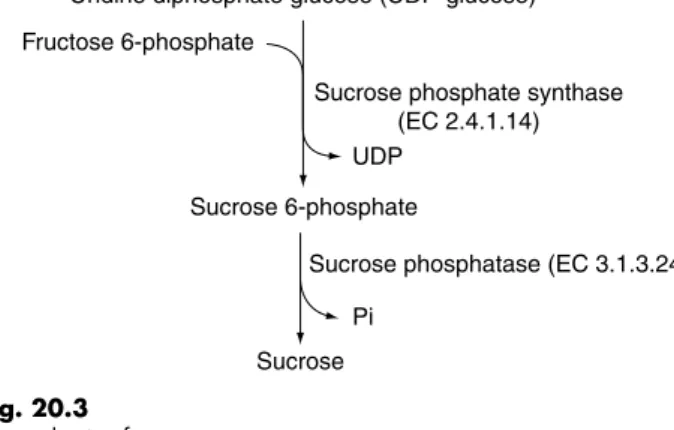
OHHOH2C
Chitin This is found in some lower plants, in insects and in crustaceans. Its incorporation into the microfibrillar component of the fungal cell wall is analogous to that of cellulose microfibrils.
COMMERCIAL PLANT-DERIVED FIBRES AND PRODUCTS
